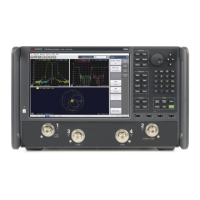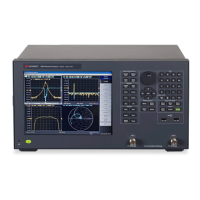Calculate the effective radiated power
The effective radiated power (ERP) is the power level at the output of the transmit an-
tenna.
E
RP
= P
source
– (L
1
+ L
2
) + G
amp
+ G
t
Where E
RP
= Effective radiated power (dBm)
P
source
= Power out of the source (dBm)
L
1
& L
2
= Loss from cable(s) between source and antenna (dB)
G
amp
= Gain of the amplier (if used) (dBi)
G
t
= Gain of transmit antenna (dBi)
Calculate the free-space loss
The free-space loss (or power dissipation, P
D
) of an antenna range determines the dif-
ference in power levels between the output of the transmit antenna and the output of
an isotropic (0dBi) antenna located at the receive site. This free-space loss is due to the
dispersive nature of a transmitting antenna. A transmitting antenna radiates a spheri-
cal wavefront; only a portion of this spherical wavefront is captured by the receiving
antenna.
For a free-space, far-eld range, this range transfer function is easily determined as
follows:
P
D
= 32.45 + 20*log (R) + 20*log (F)
where P
D
= Free-space loss (power dissipation) (dB)
R = Range length (meters)
F = Test frequency (GHz)
This equation does not account for atmospheric attenuation, which can be a signicant
factor in certain millimeter-wave frequency ranges.
Compact antenna test ranges (CATRs) achieve greater transfer efciency by collimating,
or focusing the transmitted power using one or more shaped reectors. Transfer func-
tions for most CATRs are available from the manufacturer’s data sheet or on request. If
the transfer function is unavailable, use the free-space loss as a worst-case estimate.
Calculate your range transfer function for the minimum and maximum test frequencies.
Calculate the maximum power level at the output of the AUT
The test channel received power level must be calculated to determine the approxi-
mate maximum power level present at the output of the antenna-under-test (AUT). The
required measurement sensitivity is determined from the test channel received power
level, the required dynamic range, and the required measurement accuracy. The maxi-
mum test channel received power level will occur when the AUT is boresighted relative
to the transmit antenna.
P
AUT
= E
RP
– P
D
+ G
AUT
where P
AUT
= Test channel received power level at output of AUT (dBm)
E
RP
= Effective radiated power (dBm)
P
D
= Free-space loss (dB, at the maximum test frequency)
G
AUT
= Expected maximum gain of AUT (dBi)
Note: A calculator which will derive this num-
ber for you can be found at:
http://na.tm.keysight.com/pna/antenna
Note: PAUT must not exceed the specied
compression input levels of the next com-
ponents (typically either the PNA or in more
complex systems, a mixer). See the individual
component specications for detailed infor-
mation.
25 | Keysight | Antenna Test – Selection Guide

